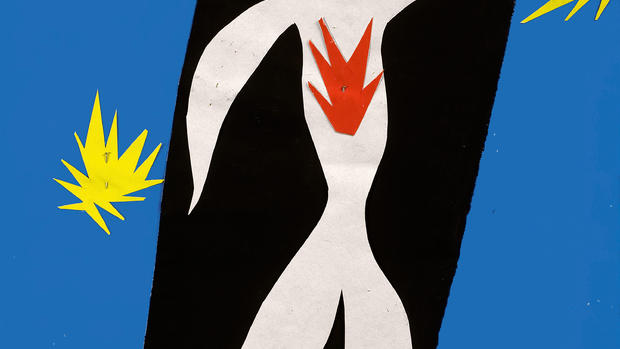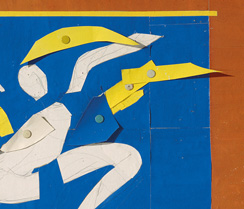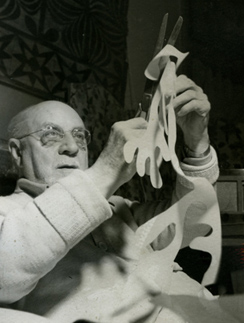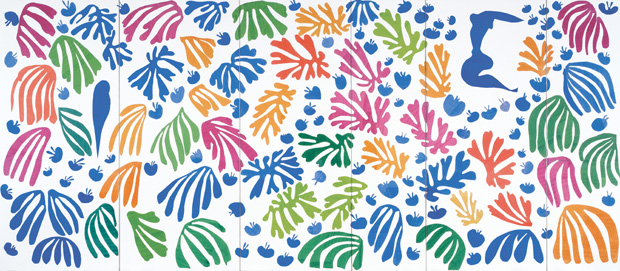Carving into color: Matisse's stunning cut-outs
The painter Henri Matisse made his name by putting brush to canvas. And when chronic illness made painting difficult, he made his mark all over again by putting scissors to paper. Martha Teichner shows us how he did it:
A flickery home movie of an elderly Henri Matisse shows the artist in a hurry with his giant scissors, cutting odd, floppy leaf forms out of paper . . . that his assistants would eventually pin to the walls of his home studio in the south of France.
In the last years of his life, Matisse -- one of the most famous painters in the world -- all but gave up painting for these huge, colorful collages made out of cut paper.
Most people think of cutting colored paper as something children do, but curator Jodi Hauptman said, "What I might say is that what he's doing is reducing form to its essentials, and that's one of his great achievements."
Hauptman, one of the organizers of "Henri Matisse: The Cut-Outs" at the Museum of Modern Art in New York, said, "Even at that point when he'd had a full career, he was well-known, he could have rested on his laurels, and he doesn't; he reaches for something new."
The Museum of Modern Art owns one of his best-known paintings, "The Dance," from 1909. But Matisse used cut-outs of dancers to figure out his composition for the famous mural commissioned in the early 1930s by the American collector, Dr. Albert Barnes.
- An art collection's new home in Philly ("Sunday Morning," 05/13/12)
Teichner noted, "All of this looks like a dressmakers' pattern."
"It does," said Hauptman. "Matisse himself actually grew up in a textile region of France, and he collected textiles. So that connection is, I think, very significant. He's working this out, he's pinning and unpinning -- really having his assistant pin and unpin these forms and he's thinking through the shapes of the figures."
For decades, the cut-outs were a means to an end, a tool, until in 1943, when Matisse was commissioned to produce a book, called "Jazz."
"There are 20 images in the book, and he uses cut paper to compose each plate," said Hauptman.
Matisse liked the look of the stuck-on bits of cut paper, but when the book was printed, all that texture was lost. Suddenly, he realized cutouts could be important -- a new art form.
Paul Matisse, an artist himself, remembers visiting his grandfather: "He had the 'Jazz' series out, all around his room, and he looked at it, and he said, 'It's the work of an invalid.' And of course he still has the urge to go and to do more."
He says his grandfather was driven to work, no matter what the personal cost.
"There were all sorts of issues, and he wasn't a cozy person," said Paul. "But mostly, it was his intensity that drove what happened around him."
A man who had to create, even though, from 1940 until his death in 1954 at the age of 84. Matisse was practically housebound, as a result of a succession of near-fatal illnesses. So, with shapes cut out of painted paper, he conjured up the world on his walls -- even a swimming pool that filled a room.
"Matisse is known to have told his assistant, 'Call a cab and let us go to a swimming pool,'" said Karl Buchberg, senior conservator at the Museum of Modern Art. "He wanted to see divers, and he got there -- there were no divers. He says, 'Let's go home. I'm gonna make myself my own swimming pool.' And that's what he did."
It was Buchberg's painstaking four-year conservation of "The Swimming Pool" that led to the exhibition.
"One of the features of our exhibition here at MoMA is that we want to show how Matisse lived with these works," said Buchberg. "They were all pinned up, and we want people to see the pins," he said.
The amazing thing about "The Swimming Pool" is that you're seeing from all directions at once -- above the swimmers, below them, alongside them, as they thrash about in the white sunlight and choppy blue water.
The color is actually many blues.
Hauptman said Matisse describes the cut-outs as "drawing with scissors," or "carving into color," like a sculpture.
In the blue nudes, it's possible to see that his cut-outs were anything but simple or childlike. They were carefully reworked and rethought.
Matisse considered a chapel in the south of France his masterpiece. From the stained glass windows to the priests' vestments, the designs were based on cut-outs.
After surviving poor health and the horrors of World War II, scissoring away, Matisse experienced what he considered a whole new life. His cut-outs exploded in size and exuberance. He compared cutting to flying.
"He did not go back to painting; he had discovered a new world, and he was just going to explore it," said Paul Matisse. He had seen some of his grandfather's cut-outs as works in progress pinned up on walls, but had never seen so many together.
They are a marvel, even to him: "I think he was just having the time of his life at this last period," he said.
One of the giants of 20th century art, Matisse said, "An artist should never be a prisoner of himself -- prisoner of style, prisoner of reputation, prisoner of success." With his cut-outs, he set himself free one last time.
For more info:
- "Henry Matisse: The Cut-Outs" at MoMA, New York (exhibition extended through February 10, 2015)
- The exhibition catalogue, "Henry Matisse: The Cut-Outs," edited by Karl Buchberg, Nicholas Cullinan, Jodi Hauptman and Nicholas Serota, is available from the Museum of Modern Art
- Download an excerpt here
- Thanks to the Museum of Modern Art. Images © 2015 Succession H. Matisse.
- henri-matisse.net







